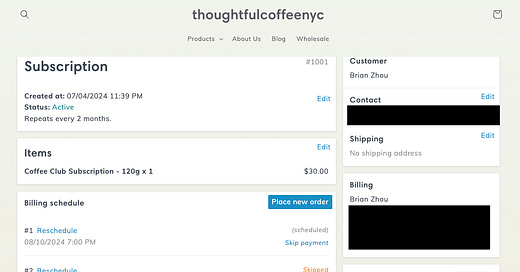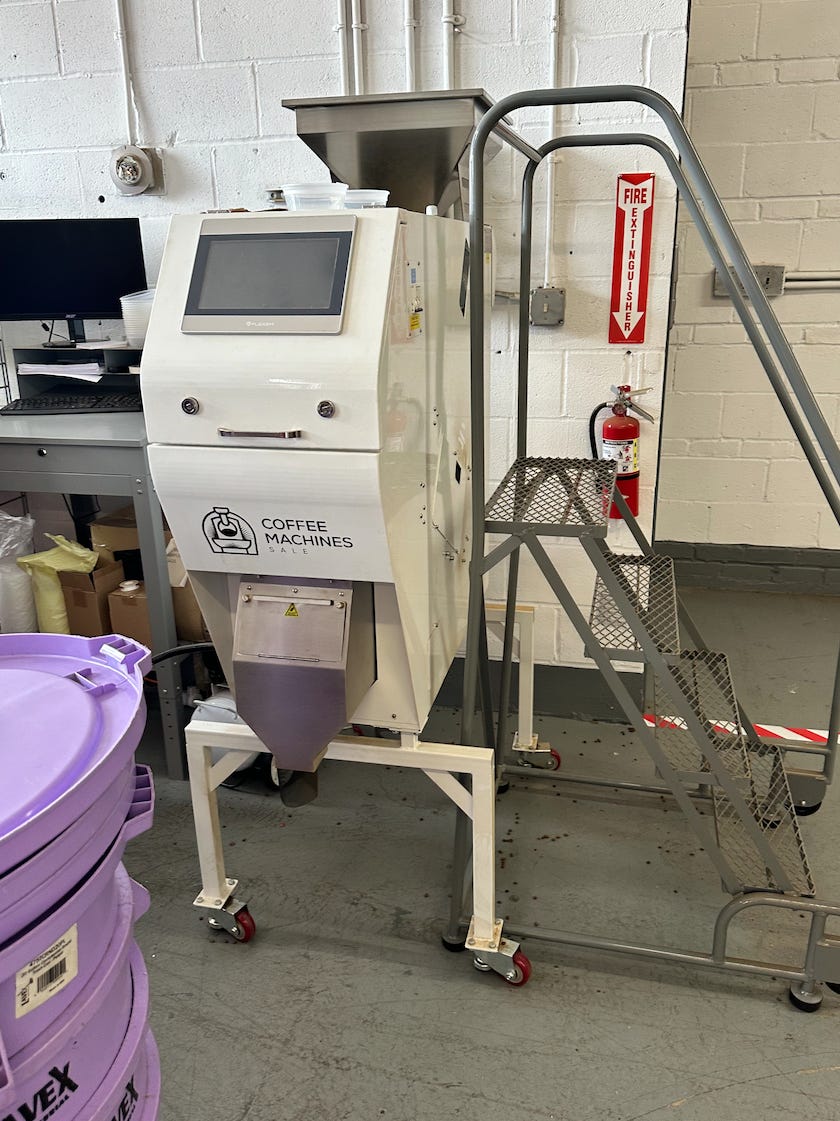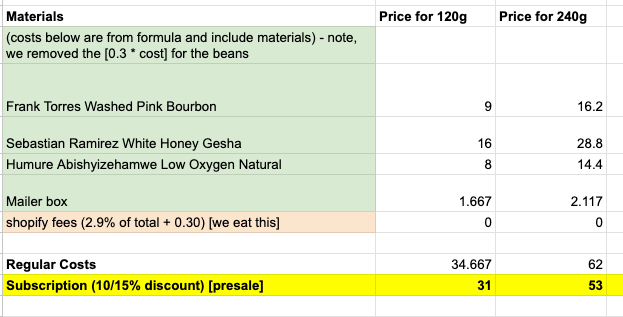Why go to the beach when you can stay home and accumulate stress. ❤️
TDLR: Head here to buy V7 or the coffee club subscription
Changes with this one:
The old presale discount is now in the form of a subscription.
We will be integrating an automatic color sorter into our QA process
Hopefully no more handwriting bags…
Will bring back a digital long-form brewing guide.
The coffee club subscription:
We've replaced the "presale" with a subscription! It's mostly the same as the presale, but the price will always be fixed.
We are using Seal Subscriptions to manage our subscriptions. We plan to run the subscription in a very flexible manner. If you accidentally forgot to cancel/pause your subscription and I haven't yet sent your box out, I'll refund you your money. I'm not trying to use the subscription to lock you in and take your money.
I’m still figuring out how to provide additional benefits to those who’ve signed up, but the main ones for now are:
Reduced pricing for coffee club boxes
10% discount code for beans (will need to figure out how to hook into an email)
priority in one-off collaborations (ceramics + tote bags, etc.), events (pastry event curation), or things I want to share (quaker tastings — read more below).
Lastly, there is a limited number of subscriptions — at least to start out. Seal subscription is a new tool, and I want to work out the kinks first and see how everything plays out for a few runs before I remove the limits.
Adding a color sorter into QA process:
The purpose of a color sorter is to help identify and remove beans that fall outside of a certain color range. Beans that are in this range typically are either over-roasted (stuck in the roaster) or are quakers (they didn’t have enough nutrients when as a fruit and don’t have enough sugars to caramelize).
I'll be shooting the beans through a color sorter for this round (and likely moving forward). I'm still learning how to integrate this tool best, but pushing beans through this color sorter does slightly bump up the end cup quality. Paolo and the multimodal team shared some great insight about how not all beans might benefit from this and how we should still cup the results to confirm if sorting out quakers makes sense for a roast.
I cupped the original roast (pre-sort), quakers from the first sort, quakers from the second sort, and the sorted batch to try to understand the impact of the color sorter. I ran this cupping method with two beans (Double Anaerobic Washed Pink Bourbon / Castillo + Colombia).
I found an increase in quality with the Castillo + Colombia. From the blind cupping, the brightest cup ended up being the sorted batch. I was also able to easily pick out the "quaker" cups, as they both exhibited very "hay" and flat "dry" qualities. The pre-sort cup tasted like the post-sort cup but with less brightness.
The results weren't as evident with the Double Anaerobic Washed Pink Bourbon. From the first sips, what seemed best was the pre-sort batch. This may be because of the wide profile spectrum this bean had and including the quakers helped stretch the profile out. Then, continuing to test the Double Anaerobic Washed Pink Bourbon throughout the month, I felt the sorted batch's perfume-y characteristics were more apparent and consistent than the pre-sort. In the end, I felt this bean still received a bump from color sorting.
There's still a lot to learn and figure out with the color sorter, but I plan to run V7's Washed Pink Bourbon and the White Honey Gesha through the sorter. I think the result will be a more refined and bright cup.
Maybe I'll toss in some quakers for subscription holders to taste/compare -- that could be fun. 👀
Pricing
We've landed at the subscription price offerings by looking at past coffee clubs and finding a price point that we felt comfortable with.
But moving forward, we will cut the 120g discount to 10%, and keep the 240g at 15%. This is to help create some pricing differentiation between the two offerings. This likely results in a $1-$2 increase. If you feel strongly about this, let me know.
Brewing Guide:
This is going to be a fun one to write... There'll be more variations in the brewing recipes across the beans this time. Maybe it's because none of these beans are heavily processed this time around, but it might require a bit more tweaking to get the brew right.
We will continue dialing in with the Hario Switch/V60.
The schedule:
Run the test roast on July 20th (will likely release to shop afterwards)
Run the production roasts on July 26th.
Pack orders on July 28th and have shipping orders ready to ship the day of (will ship from the roastery).
Have in-person pickup on August 3rd. If you'd like it earlier, we can coordinate pickup from July 30th onwards, but honestly, the rest times for these are two weeks minimum, so there's not a huge benefit of picking up early (unless you are gifting or will be out of town).
The Coffees:
This box overall will be less "flavorful" than the past. On a scale of 10, I'd peg this as a 7. None of the beans are super perfume-y, and the flavors aren't super in-your-face (think co-ferment). Where this box shines on is complexity and having that summer-vibe :).
White Honey Gesha:
Origin: Colombia
Region: Quindío
Farm: Finca El Placer
Farmer: Sebastian Ramirez
Varietal: Gesha
Processing: White Honey
Elevation: 1744 masl
Profile: Complex, florals(ish), bright
About the coffee:
The cherries were collected and sorted to ensure that 95% were ripe and 5% were semi-ripe. The beans were then submerged and underwent anaerobic fermentation in 200-L tanks at a constant temperature of 18C. Throughout this process, CO2 was injected for 48 hours.
After this fermentation step, the beans underwent controlled drying using shade nets. Finally, they were packaged in grain-pro bags and stabilized for 15 days.
Roaster's notes:
Complexity. I've been saying it's florals, but I don't know if that's the right term to describe this.
This bean is a top-3 bean for me this year. This bean does a good job of exemplifying how I interpret "complexity" in a cup. I don't know -- it's hard to describe. I can see why it was used for Kissick's world barista chamiponship routine.
On the cupping table, this bean initially tasted super dry and lackluster. It wasn't until about two months post-roast, when I was tossing out my old coffee samples that I decided to give this bean a final brew and realized how complex it was.
Washed Pink Bourbon:
Origin: Colombia
Region: Nariño, La Union
Farm: Finca La Indonesia
Farmer: Frank Torres
Varietal: Pink Bourbon
Processing: Washed
Elevation: 1870 masl
Profile: Clean, light acidity, some florals
About the coffee:
The harvested Pink Bourbon cherries were measured for their sugar content, ensuring a reading of 22 degrees Brix before processing. The cherries were floated in water to remove defects and then washed in an ozonated water mixture. The remaining cherries were put into food-grade plastic and dry fermented for 48 hours before being depulped. The depulped coffee then goes through a dry fermentation for 72 hours. The coffee is then rinsed and dried on beds for 20-25 days. Finally, the process finishes with 1-2 hours a day of unconvered sun exposure daily until it reaches its target moisture level.
Roaster's Thoughts:
Clean, with balanced acidity.
On the cupping table, I noticed many floral characteristics, initially pinning this to be a gesha. But it wasn't! Maybe this fun surprise alone convinced me to purchase this bean 🥲.
This might be the least funky coffee I've offered.
Humure Abishyizehamwe Low Oxygen Natural:
Origin: Rwanda
Region: Gatsibo, Rwanda
Washing Station: Humure Abishyizehamwe
Farmers: Local smallholder farms
Varietal: Red Bourbon
Processing: Low Oxygen Natural
Elevation: 1800 masl
Profile: Watermelon-ish, tart, more on the funk-y side
About the coffee:
The cherries were first sorted for any visible defects. The cherries were then floated to discard the less dense cherries at the top. The denser cherries (at the bottom) were then packed and sealed into plastic tanks and left to ferment for 72 hours. After this fermentation period, the cherries were turned onto raised drying beds for drying.
Once the moisture content reached 20%, the cherries were covered with mesh netting for five days before exposure to full sun. At 15% moisture content, the cherries were moved under complete shade for five days before being exposed again to full sun. Both ways of drying were thought to alter the rates of drying to promote more fruit flavor complexity. The total drying period was 38 days for this coffee.
Roaster's Thoughts
This is the funky boi of this batch. I don't get umami funk, but more... tart and dry funk.
What drew me to this bean was I got light hints of watermelon. It felt like the perfect bean to throw into a summer lineup.
Final thoughts:
I feel this one might be where growth dips. I think having the discount tied to a subscription might discourage some people — which I totally understand.
It’s also just hard not to judge myself off of how many things I sell. I need to stop focusing on that, and just focus on continuing to source good coffee and improve (on roasting, sourcing, etc.), and hope that sales comes as a side effect.
Sorry — just needed a place to vent a bit. Nonetheless, we keep moving forward.
Thank you’s:
All the people who’ve subscribed. You don’t know how much it means to me that you’ve subscribed. The coffee roasting scene is insanely competitive, so I’m really appreciative you trust me enough to be a consistent contributor to your coffee inventory. I’m honestly just super touched. 🙇♂️ 🙇♂️ 🙇♂️












I’m stoked that you’re still going and that you’re still taking the time to write about it.